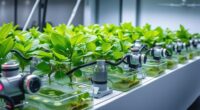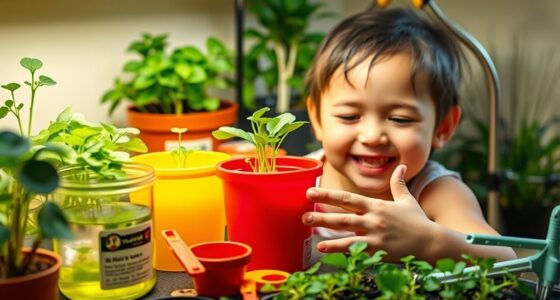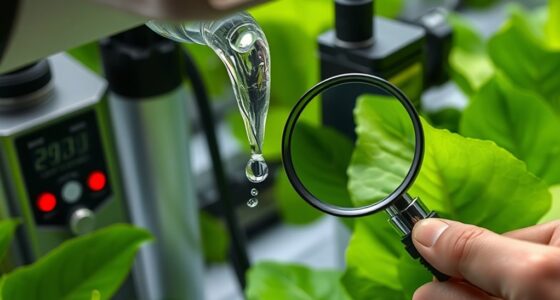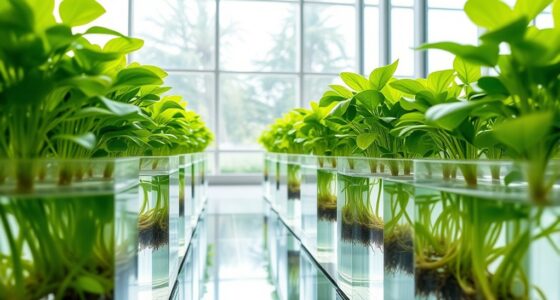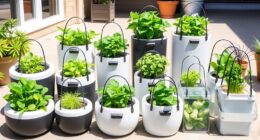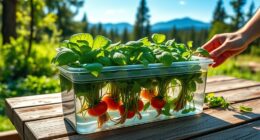The science behind the Nutrient Film Technique shows how a thin, continuous flow of nutrient-rich water delivers both nutrients and oxygen directly to your plant roots. This flow creates a dynamic environment that promotes faster growth and healthier plants by balancing water movement, oxygen exchange, and nutrient uptake. Proper flow rate and system design are key to preventing issues like root rot or stagnation. Keep exploring to discover how to optimize this innovative hydroponic method for your setup.
Key Takeaways
- NFT uses a thin, continuous flow of nutrient-rich water to supply plants’ roots, combining water and oxygen for optimal growth.
- Proper water flow rate and channel slope are essential to maximize nutrient delivery and oxygen exchange without drowning roots.
- Maintaining balanced nutrient concentration and water flow enhances plant health, accelerates growth, and prevents root rot.
- Regular monitoring of pH and nutrient levels ensures system efficiency and supports healthy root development.
- Understanding water and oxygen dynamics allows you to optimize NFT systems for higher yields and resilient plant growth.

The nutrient film technique (NFT) is a popular method of hydroponic farming that relies on a thin, continuous flow of nutrient-rich water to nourish plants. This system allows you to maximize hydroponic efficiency by providing a steady supply of nutrients directly to the roots, which promotes rapid and healthy plant growth. Understanding the science behind NFT helps you optimize your setup for better yields and healthier plants.
NFT uses a continuous flow of nutrient-rich water to boost plant growth and maximize hydroponic efficiency.
At its core, NFT capitalizes on the principles of plant growth dynamics. When you create a shallow stream of water that consistently flows over the root zone, you ensure that roots are constantly exposed to oxygen and nutrients. This balance between water and air is crucial because roots need oxygen to absorb nutrients effectively, and too much water can drown them or lead to root rot. By maintaining a thin film of water, you enhance oxygen availability, which accelerates plant development and improves overall vitality.
The flow rate of the nutrient film is a key factor in hydroponic efficiency. If the water moves too quickly, roots may not absorb enough nutrients, and if it moves too slowly, oxygen exchange could diminish. You want to find that sweet spot where the flow is steady enough to deliver nutrients uniformly while allowing oxygen to diffuse into the root zone. Proper channel slope and timing help you achieve this balance, ensuring the roots get a continuous, fresh supply of nutrients without water stagnation.
In addition, the dynamic nature of this nutrient flow influences plant growth dynamics considerably. As plants take up nutrients, the concentration of nutrients in the water decreases, so your system needs to be regularly monitored and adjusted to maintain optimal levels. This constant movement and replenishment create a dynamic environment where roots adapt quickly, promoting vigorous growth. The flow also helps prevent the buildup of harmful pathogens and algae, which can thrive in stagnant water, thereby reducing disease risk and maintaining a healthy root zone.
To maximize your success with NFT, you should pay close attention to factors like nutrient concentration, flow rate, and channel design. Regularly testing your water’s pH and nutrient levels ensures plants receive what they need at each stage of growth. Adjusting these parameters based on plant response allows you to fine-tune the system for peak hydroponic efficiency. Additionally, understanding how roots need oxygen and nutrients interact in the flow environment enables you to create a more resilient and productive hydroponic system. By understanding the underlying science—how water flow influences oxygen levels, nutrient uptake, and plant growth dynamics—you can create a thriving hydroponic garden that yields faster growth and healthier plants.
Frequently Asked Questions
What Are the Main Benefits of NFT Over Traditional Farming?
You’ll find that NFT offers significant benefits over traditional farming, especially in hydroponic efficiency and water conservation. It uses less water by recirculating nutrient-rich solutions, reducing waste. Plus, you get faster growth rates and higher yields because plants receive direct, consistent nutrients. This system minimizes land use and lowers overall resource consumption, making it a smarter, more sustainable choice for growing crops compared to conventional methods.
Can NFT Be Used for Growing Root Vegetables?
You might be biting off more than you can chew trying to grow root vegetables with NFT, as it’s not exactly a one-size-fits-all solution. Root vegetable compatibility with NFT is limited because the technique’s shallow, fast-moving nutrient film isn’t ideal for their growth. While NFT excels with leafy greens, its limitations mean you should explore other hydroponic methods better suited for root crops. Don’t put all your eggs in one basket.
How Do You Prevent Algae Buildup in NFT Systems?
To prevent algae buildup in your NFT system, focus on algae control by keeping your water well-covered and limiting light exposure. Make sure your water circulation is consistent and strong, which discourages algae growth by preventing stagnant areas where algae can thrive. Regularly clean your system and avoid overfeeding, as excess nutrients can promote algae. These steps help maintain a healthy, algae-free environment for your plants.
What Are Common Issues Faced With NFT Setups?
In NFT setups, you might face issues like pest management problems and nutrient imbalances. Pests can damage plants, so inspect regularly and use organic controls. Nutrient imbalances can stunt growth or cause deficiencies, so monitor your water’s pH and nutrient levels consistently. Additionally, algae buildup and root diseases are common. Address these problems promptly with proper cleaning, maintaining ideal conditions, and ensuring good airflow to keep your system healthy and productive.
Is NFT Suitable for Large-Scale Commercial Farming?
Imagine a thriving river feeding a vast landscape—NFT can scale like that, but it’s not without hurdles. For large-scale commercial farming, you’ll face scaling challenges, ensuring consistent flow and nutrient distribution over extensive areas. While it supports crop diversity, managing multiple varieties on a big scale can get complex. Still, with careful planning, NFT can be a powerful tool for commercial farms, but it demands vigilance and fine-tuning.
Conclusion
Just like Icarus dared to soar higher, the nutrient film technique lets you elevate your gardening game with precision and innovation. By understanding its science, you harness a powerful tool that nurtures plants efficiently, even in tight spaces. So, take the leap—embrace this method and watch your green dreams take flight, soaring beyond traditional limits. With knowledge as your wings, you’ll cultivate success that’s truly out of this world.

